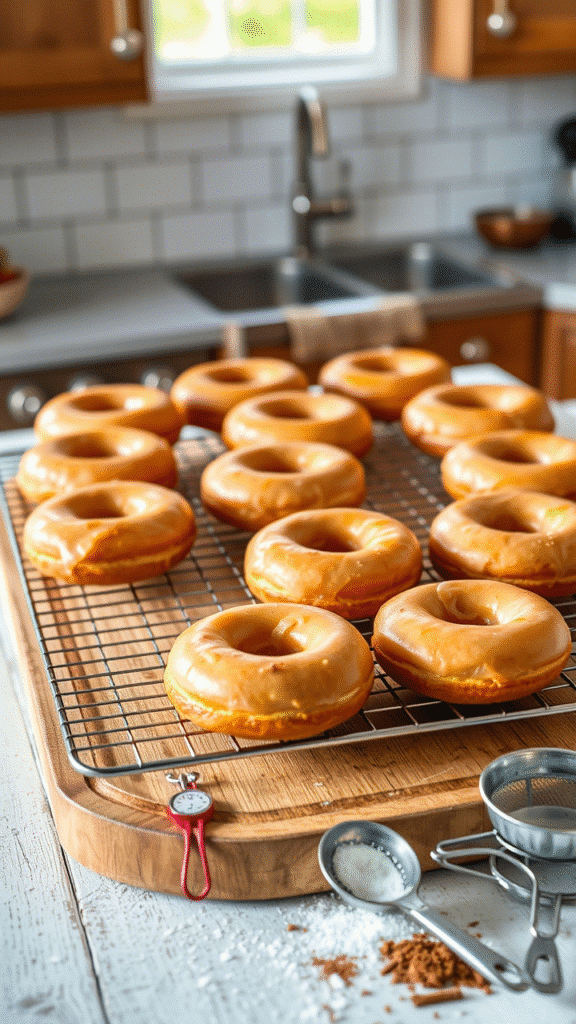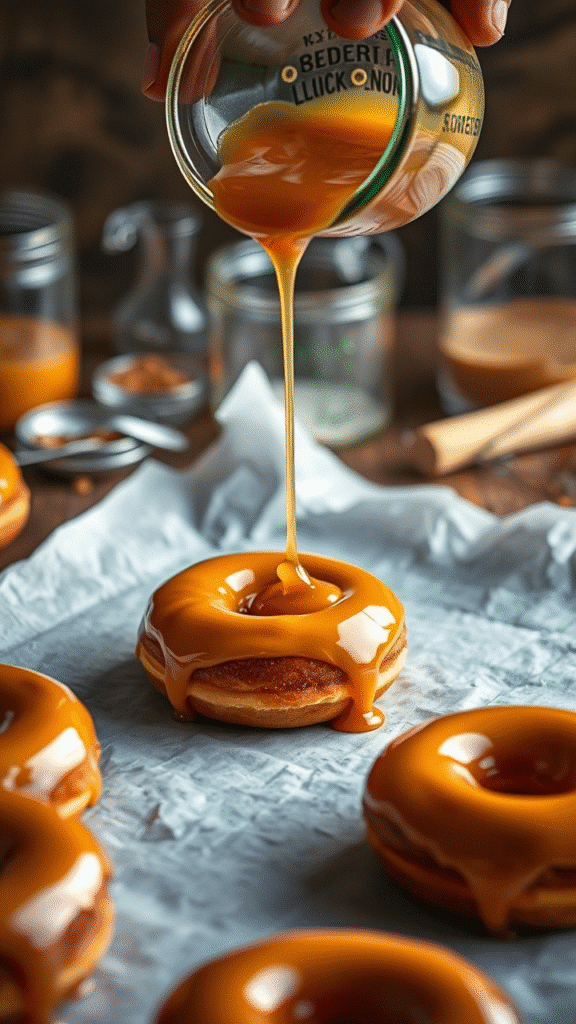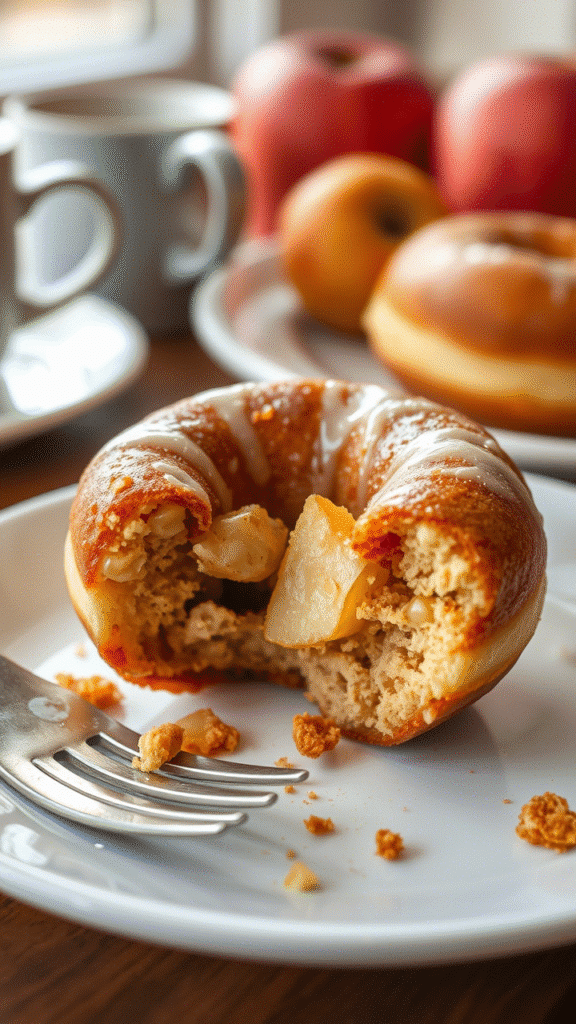The scent hit me before I even walked through the orchard gate—that intoxicating blend of caramelized apples, warm spices, and fresh-fried dough that signals autumn’s arrival in New England. I was twelve, clutching my mother’s hand as we approached the farmstand where Mrs. Henderson had been making apple cider donuts the same way for forty-three years. That first bite changed everything I thought I knew about donuts.
Most people think apple cider donuts are just cake donuts with apple flavor thrown in. They’re wrong. The real magic happens when you reduce fresh apple cider into a concentrated essence that infuses every molecule of the dough. It’s a technique that transforms an ordinary pastry into something that captures the very soul of autumn in each tender, spiced bite.
These aren’t your typical grocery store donuts masquerading as seasonal treats. This recipe creates dense, moist rings with a tender crumb that practically melts on your tongue, while delivering that deep apple complexity that only comes from proper cider reduction. The exterior develops a delicate crust when fried correctly, providing just enough resistance before giving way to the pillowy interior.
The Secret Behind Exceptional Apple Cider Donuts
What separates amateur attempts from professional-quality apple cider donuts lies in understanding three critical elements: cider reduction, dough hydration, and frying technique. Most home bakers skip the reduction step, thinking they can simply substitute cider for milk. That’s like trying to make espresso with regular coffee—you’ll get something that tastes like coffee, but it won’t have the concentrated intensity that defines the real thing.
The reduction process concentrates the apple sugars and acids, creating a syrup that’s approximately four times more potent than fresh cider. This concentration doesn’t just add flavor; it fundamentally changes the dough’s structure and moisture retention. Professional bakeries know this secret, which is why their donuts taste so much more complex than homemade versions.
Temperature control during mixing and frying makes the difference between donuts that absorb too much oil and become greasy versus those that develop that perfect golden crust while staying light inside. The dough should feel slightly tacky but not sticky—a distinction that comes with experience but can be achieved by following precise measurements and techniques.
Ingredients & Substitutions
Essential Ingredients
For the Reduced Apple Cider:
- 2 cups fresh apple cider (not apple juice—there’s a significant difference)
- 1 cinnamon stick
- 2 whole cloves
For the Donut Dough:
- 2 cups all-purpose flour (preferably unbleached)
- 3/4 cup granulated sugar
- 2 teaspoons baking powder
- 1 teaspoon ground cinnamon
- 1/2 teaspoon freshly grated nutmeg
- 1/2 teaspoon salt
- 1/4 teaspoon ground ginger
- Pinch of allspice
- 1/3 cup reduced apple cider (cooled)
- 2 large eggs, room temperature
- 4 tablespoons unsalted butter, melted and slightly cooled
- 1/3 cup buttermilk
For Finishing:
- Vegetable oil for frying (canola or peanut oil work best)
- 1 cup granulated sugar mixed with 1 tablespoon ground cinnamon
Professional Substitution Guide
Cider selection matters more than most realize. Fresh-pressed cider from local orchards contains more suspended solids and natural yeasts, which contribute to flavor complexity. If unavailable, look for cider that’s cloudy rather than clear—avoid anything labeled “apple juice” as it lacks the necessary concentration and flavor compounds.
For dietary modifications, all-purpose flour can be substituted with a 1:1 gluten-free flour blend, though the texture will be slightly more delicate. Add an extra tablespoon of liquid if using gluten-free flour, as these blends typically absorb more moisture. Buttermilk can be replaced with regular milk plus 1 teaspoon lemon juice, but the tang from real buttermilk balances the sweetness perfectly.
Butter alternatives include neutral oil (increase to 5 tablespoons) or even apple butter (reduce other liquids slightly). However, butter provides both flavor and structure that’s difficult to replicate completely. For egg substitutions, use 2 tablespoons ground flaxseed mixed with 6 tablespoons water, though this will produce a denser final product.
Spice quality makes a dramatic difference. Freshly grated nutmeg has about ten times the potency of pre-ground versions. Cinnamon should be Ceylon rather than Cassia if available—it’s more complex and less harsh. The ginger adds a subtle warmth that most recipes omit, but it’s crucial for authentic flavor depth.
Step-by-Step Instructions

Phase 1: Cider Reduction (30 minutes ahead)
Start with the cider reduction first, as it needs time to cool before incorporating into the dough. Pour cider into a heavy-bottomed saucepan with the cinnamon stick and cloves. Bring to a boil over medium-high heat, then reduce to maintain a steady simmer.
Don’t walk away during this process. The reduction will seem slow initially, then accelerate rapidly near the end. You’re looking for approximately 1/3 cup of thick, amber syrup that coats a spoon. This typically takes 20-25 minutes, but timing varies based on your pan and heat source.
Remove the whole spices and let the reduction cool completely. It should have the consistency of maple syrup when cooled. If it becomes too thick (like honey), thin with a tablespoon of fresh cider. This reduction can be made days ahead and stored refrigerated.
Phase 2: Dough Preparation
Whisk together all dry ingredients in a large bowl, ensuring even distribution of spices. The key to tender donuts is minimal mixing once liquids are added, so having dry ingredients well-combined first is essential.
In a separate bowl, whisk eggs until smooth, then add the cooled cider reduction, melted butter, and buttermilk. The mixture might look slightly curdled—that’s normal due to the acid in the buttermilk and cider.
Pour the wet ingredients into the dry ingredients and fold together with a rubber spatula just until combined. The dough should look shaggy and slightly lumpy. Overmixing develops gluten, resulting in tough donuts—resist the urge to achieve smoothness.
Phase 3: Shaping and Resting
Turn the dough onto a lightly floured surface. It will be soft and slightly sticky. Pat gently into a rectangle about 3/4 inch thick. Don’t use a rolling pin aggressively; gentle patting maintains the dough’s delicate structure.
Cut donuts using a donut cutter or two round cutters (3-inch for donuts, 1-inch for holes). Dip cutters in flour between cuts to prevent sticking. Gather scraps gently and re-roll once—subsequent re-rolling makes tough donuts.
Let cut donuts rest on a floured baking sheet for 10 minutes. This brief rest allows the baking powder to activate and the flour to fully hydrate, resulting in more uniform frying and better texture.
Phase 4: Frying Perfection
Heat oil to 375°F in a heavy pot or deep fryer. Use enough oil so donuts can float freely—typically 3-4 inches deep. Temperature accuracy is crucial; use a reliable thermometer rather than guessing.
Fry 3-4 donuts at a time to avoid overcrowding, which drops oil temperature. Slide donuts into oil gently using a slotted spoon. They should sizzle immediately and begin rising to the surface within 30 seconds.
Fry for 90 seconds on the first side until golden brown, then flip carefully and fry another 60-90 seconds. The second side always cooks faster. Donuts are done when they sound hollow when tapped and maintain their shape when lifted.
Remove donuts to a wire rack set over paper towels. Let drain for 30 seconds before tossing in cinnamon sugar while still warm. The residual heat helps the coating adhere properly.
Cooking Techniques & Science
The science behind perfect apple cider donuts involves understanding how different components interact during mixing and frying. The reduced cider contributes concentrated sugars that promote browning through the Maillard reaction—the complex chemical process that creates flavor compounds when proteins and sugars are heated together.

Buttermilk serves multiple purposes beyond flavor. Its acidity reacts with baking powder to create additional lift, while also tenderizing gluten proteins. This dual action creates donuts that are both light and tender without being fragile.
Oil temperature control prevents grease absorption while ensuring proper cooking. Too low, and donuts absorb oil and become heavy. Too high, and the exterior burns before the interior cooks through. The 375°F target represents the sweet spot where moisture in the dough creates steam that pushes oil away while the exterior develops that perfect golden crust.
The brief resting period after cutting isn’t just convenience—it’s chemistry. During this time, the flour continues hydrating, and the leavening agents begin their work. Donuts that go straight from cutting to oil often have uneven texture and poor rise.
Professional bakers understand that donut dough should never be overworked. Unlike bread, where gluten development is desirable, donut dough benefits from minimal mixing to maintain tenderness. The dough’s slightly sticky texture indicates proper hydration—too much flour makes dense donuts.
Serving & Pairing Suggestions
Apple cider donuts shine brightest when served warm, ideally within an hour of frying. The contrast between the crisp, cinnamon-sugar exterior and the tender, spiced interior is most pronounced when fresh. However, they maintain quality for up to two days when stored in an airtight container.
For presentation, arrange donuts on a rustic wooden board with small bowls of additional cinnamon sugar and perhaps some apple butter for dipping. Fresh apple slices and a few cinnamon sticks create an appealing seasonal display that emphasizes the donuts’ orchard origins.
Beverage pairings should complement rather than compete with the donuts’ spiced apple character. Hot apple cider is the obvious choice, but consider chai tea, which echoes many of the same spices. Strong black coffee provides a bitter counterpoint to the donuts’ sweetness, while a good porter or brown ale offers surprising harmony for adult occasions.
For special presentations, these donuts can be glazed instead of sugared. A simple mixture of powdered sugar, cream, and vanilla creates an elegant finish. Maple glaze works beautifully too, enhancing the autumn theme. Some bakeries offer a bourbon glaze that adds sophistication for adult palates.
Troubleshooting Common Issues
Dense donuts usually result from overmixing the dough or using too much flour. The dough should feel slightly tacky—if you can handle it without any sticking, you’ve probably added too much flour. Remember that donut dough is meant to be softer than cookie dough.

Greasy donuts indicate oil temperature problems or overcrowding during frying. Always return oil to proper temperature between batches, and never rush the process by frying too many at once. Proper temperature creates that barrier of steam that prevents oil absorption.
If donuts crack during frying, the oil is too hot, or the dough was overworked. Cracks indicate rapid surface cooking that doesn’t allow the interior to expand properly. Reduce heat slightly and ensure gentler mixing next time.
Donuts that lose their shape during frying suggest underdeveloped dough structure or incorrect cutting technique. Make sure your dough rests adequately, and cut straight down without twisting the cutter, which can seal edges and prevent proper rising.
Advanced Variations for the Adventurous Baker
Once you’ve mastered the basic technique, consider these professional variations. Apple brandy can replace some of the buttermilk for a more sophisticated flavor profile—use no more than 2 tablespoons, as alcohol affects dough structure.
Caramel apple donuts involve adding 2 tablespoons of caramel sauce to the wet ingredients and finishing with a caramel glaze. Brown butter donuts substitute browned butter for regular melted butter, adding nutty complexity that pairs beautifully with apple and spices.
For texture variation, fold 1/2 cup finely diced fresh apples into the finished dough. Choose firm varieties like Honeycrisp or Granny Smith that won’t break down during frying. Pat the diced apples dry before incorporating to prevent excess moisture.
Professional bakeries sometimes add a tablespoon of apple brandy or bourbon to their cider reduction, cooking off the alcohol while retaining the flavor compounds. This technique requires careful attention to prevent burning, but the depth it adds is remarkable.
The real secret that separates professional operations from home kiters lies in consistency and quality control. Measure ingredients by weight when possible, maintain detailed notes about timing and temperatures, and never compromise on ingredient quality for convenience.
These apple cider donuts represent more than just a seasonal treat—they’re a connection to agricultural traditions and regional foodways that deserve preservation and respect. When made properly, they capture the essence of autumn in a way that mass-produced alternatives never can.
The investment in time and technique pays dividends in flavor and satisfaction that extends far beyond the kitchen. There’s something deeply satisfying about creating food that connects us to seasons, traditions, and the simple pleasure of exceptional ingredients handled with skill and care.
Frequently Asked Questions?
Can I make the dough ahead of time?
Donut dough is best used fresh, but you can refrigerate it for up to 24 hours. Cold dough is actually easier to handle and cut, though you’ll need to let it come to room temperature for about 15 minutes before frying. The texture will be slightly denser but still delicious. Never freeze the dough, as the leavening agents lose effectiveness.
What’s the difference between apple cider and apple juice in this recipe?
Apple cider contains more apple solids and natural sugars, creating a more complex flavor when reduced. Apple juice is filtered and often contains added sugars that don’t concentrate properly. If you must substitute apple juice, use 100% juice and add a pinch of apple pie spice to compensate for the reduced complexity. The final flavor won’t be quite as authentic.
How do I know when the oil temperature is correct without a thermometer?
Drop a small piece of dough into the oil—it should sizzle immediately and rise to the surface within 10-15 seconds. If it sinks and bubbles slowly, the oil isn’t hot enough. If it bubbles violently and browns quickly, it’s too hot. However, investing in a reliable thermometer is worth it for consistent results.
Can these donuts be baked instead of fried?
While you can bake them at 375°F for 12-15 minutes in donut pans, the texture and flavor will be significantly different. Baked versions are more like cake donuts without the characteristic tender crumb and slight oil flavor that defines traditional apple cider donuts. They’re still tasty but represent a different category of pastry.
Why did my cinnamon sugar coating not stick properly?
The coating adheres best when donuts are still warm from frying but not so hot that they melt the sugar. Wait about 30 seconds after removing from oil, then toss immediately. If the donuts have cooled too much, lightly brush with melted butter before coating. Store-bought cinnamon sugar often contains anti-caking agents that don’t adhere as well as homemade versions.

Veronica is a passionate food enthusiast with over three years of experience in exploring and writing about diverse cuisines. Her expertise lies in reviewing restaurants, sharing creative recipes, and discovering the latest food trends. As the voice behind FoodieRecap.com, Anju brings fresh perspectives and culinary insights to her audience.
